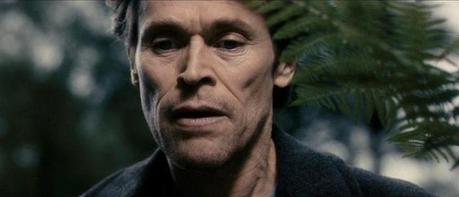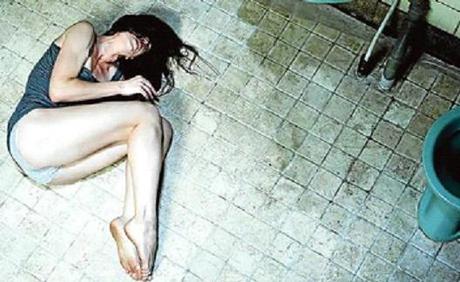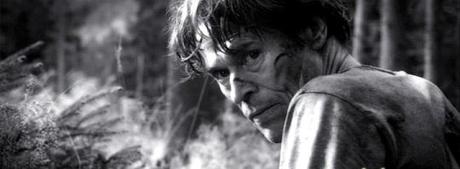An inherent trap of film criticism is reductionism. We set out to prove a thesis, which always poses the risk of binding rather than revealing. Life is rarely so simple. Such is the case with Lars von Trier’s Antichrist. I set out to write “Why Antichrist is Not a Misogynistic Film” and instead came to realize the film is far more complicated than any simple argument can encapsulate. Instead of proving whether the film is or is not misogynistic, I’ve proven that nothing about Antichrist will allow itself to be so easy, so neat.
Antichrist is Lars von Trier’s 2009 two-person film about an unnamed couple (Charlotte Gainsbourg and Willem Dafoe in searing performances) coping with the accidental death of their son. ‘He’ is a therapist, coping with his own grief by taking on the responsibility of helping his wife cope with her extreme reaction to the death. The first half of the film is an intense emotional drama, chronicling the suffering of anxiety and despair. The second half takes a significant turn, however, when Dafoe (the characters will hereafter be referred to by the actor’s names, for clarification) brings Gainsbourg into the woods as part of her exposure therapy. Gainsbourg ascribes meaning to the place, she had been there before with their son, and associates it with the evils of nature—“Satan’s church”.

The film came under considerable fire at Cannes, both for its graphic nudity, explicit violence, and alleged misogyny. It has also been critically hailed, immediately picked up for distribution by the Criterion Collection, earning a handful of awards, all veiled in a well-deserved notoriety. Several serious attempts at critical analysis have been more or less successful. Ian Christie’s fine analysis for the Criterion release—“All Those Things That Are to Die”—ties the film with references as diverse as Hieronymus Bosch and Charlotte Bronte and argues that its assault on good taste and convention serve to explore the concepts of the “monstrous feminine”, “nature as Satan’s church”, anxiety, theology, therapy, mythology and the history of misogyny. Christie wisely raises more questions than he answers and offers no solid analysis of the characters. Tina Beattie, professor of Catholic studies at Roehampton University, England, attempts to answer the film’s ultimately unanswerable questions by positing that the film is a direct Genesis allegory. Although she offers a strong argument for her hypothesis, once more Antichrist proves to be more complex and troublesome than any simple analysis can dissect. Beattie offers a brilliant analysis of Gainsbourg’s grieving ‘She’, as both a Madonna, a whore and a “mater dolorosa, the mother of sorrows whose grief is too vast to be contained”, but falls short in attempts to explain away Dafoe’s ‘He’.
Lars von Trier has said that he understands She better than he understands He, and this is a consensus shared by most after viewing Antichrist. In fact, it is the character of ‘He’, who experiences the most bizarre and horrific occurrences, that is most neglected in critical analysis. ‘He’ is mostly explained away as a black and white representation of masculinity and rationality, the Western man, who attempts to control the uncontrollable ‘She’. The widely held assumption that Gainsbourg’s ‘She’ is the more complex character, the more worthy of analysis, is premature and shortsighted. ‘He’ experiences most of the supernatural events, including the film’s most bizarre character—the talking fox of ‘Pain’. What can be said of his encounter with a talking animal (an event Gainsbourg, significantly, does not witness)? Are these events to be taken literally, or are they indicative that Dafoe is not as rational and in control as we might assume? Is this his way of dealing with suppressed grief or is he truly more in tune with nature than the wild woman?

Additionally, unlike many assumptions about Dafoe’s ‘control’ of Gainsbourg, he is presented as a gentle and almost superhumanly forgiving husband. She begins attacking him early in the film, first with accusations and later with violence. In the first half of the film Gainsbourg cruelly taunts Dafoe for missing out on his son’s last summer (“Too bad,” she mocks) and repeatedly demands sex, grabbing for his penis wildly to use it as a cure-all for her emotional pain. When Dafoe does give in, he is the one who assumes the guilt, berating and blaming himself (“Worst thing I could’ve done to you”). Later, during one of the film’s deceptively sweet moments, while playing in bed, Gainsbourg breaks the mood by biting Dafoe’s nipple too hard, foreshadowing the sexual violence to come. Through all of these early signs of abuse, Dafoe’s patience and reassurance are hardly the marks of a dominator.
In fact, ‘He’ is consistently dominated. Dafoe is both literally and figuratively raped in the film’s final turning point, as Gainsbourg uses and finally mutilates his genitals. Rather than fight, Dafoe passes out and awakens to find himself figuratively penetrated by a stone screwed into his leg and nearly immobile. Even at this extreme point, Dafoe remains passive until compelled by pure survival instinct (as well as the reoccurring element of panic) to react. Even when presented with instance after instance of his wife’s insanity—including evidence of her deliberate deformation of their son’s feet—Dafoe remains foolishly calm. When he discovers his wife’s abandoned research, there is a moment akin to Stanley Kubrick’s The Shining, as the writing devolves from neat and orderly to completely incomprehensible scrawls. Unlike The Shining, however, this is not the “a-ha” moment for Dafoe of his wife’s instability; his moment comes much too late. Even after being mutilated and nearly killed, Dafoe seems to forgive Gainsbourg as she pulls him from the dirt, telling her calmly, “We need to get this thing off me.” Forgiving past the point of naiveté, Dafoe is unwise (one could argue even ‘irrational’) but far from manipulative.

When Dafoe finally does react and strangle his wife, it is no more proof of his domination or rationality as it is additional proof of his irrationality. Contrary to the way the scene is often discussed, Dafoe does not make a conscious, lucid decision to kill Gainsbourg, finally believing her to be evil. He instead has a panic attack (as evidenced by the black and white shots of the back of his head, corner of his neck and his chest that were encoded to be “panic” earlier in the film) and lashes out irrationally, as Gainsbourg has repeatedly throughout the film. It is not so much evidence of Gainsbuorg’s evil or Dafoe’s masculine supremacy as it is evidence of Dafoe’s human fear and irrationality.
Gainsbourg, for her part, is not simply fighting against the bonds of control, either. After she brutally attacks Dafoe and he manages to flee, she begins screeching with the force of a domestic abuser. “How dare you leave me?!” she screams, after deforming Dafoe and leaving him for dead in a shack.
Additionally, Dafoe seems to be the character most in tune with the natural world, which directly contradicts easy associations that place him on the opposite side of Gainsbourg’s nature-obsessed She. Dafoe experiences all of the encounters with the Three Beggars; Gainsbourg’s only real interaction with any of them is to hear the crow of Despair, who first gives away Dafoe and then saves him. Most of the natural asides happen to Dafoe, who wanders aimlessly in the woods and communes with it even as he is seemingly assaulted by it (the leeches, or growths, on his hand for instance) Despite her supposed connection to nature, Gainsbourg’s only encounter with an unnatural event is in the form of a human child’s scream. Nature steps up to protect Dafoe, blocking him off from Gainsbourg’s hacking spade as she tries to kill him, before Dafoe is reborn through the dirt. Nature even seems to reflect Dafoe’s inner mind and emotional state, as a sudden downpour of rain inexplicably soaks Dafoe immediately after he witnesses the talking fox Pain. Why, then, would he represent modern civilization?

None of this makes for a very straight-forward analysis. Antichrist has the facade of didacticism but no answers. Nothing about the film is clean or simple, and there is no easy distinction between ‘He’ and ‘She’. Despite the temptation to place them on opposing sides of a dichotomy due to their difference in gender and namelessness, Dafoe and Gainsbourg are not entirely different. Both show signs of irrationality and a connection to and fear of the natural world. Both transform their grief into other emotions: Gainsbourg into anger and aggression and Dafoe into numbness and neutrality.
I cannot argue that Dafoe is a representation of Christ or of Adam, or that he is or isn’t ‘modern man’, no more than I can label Gainsbourg a simple mother or whore. Rather than writing off Dafoe’s “suffering masculine” as simply the flipside of the “monstrous feminine”, I believe the character deserves a richer analysis. Until ‘He’ is examined as something more than the cause of Gainsbourg’s pain, or the rational flipside of her instability, discussion of the film feels incomplete. Nothing about the film is orderly or neat, even Dafoe’s seemingly straight-forward He. On repeated viewings, his connection to nature, and his foolish, nearly irrational passivity complicate the accepted picture of the film, from a story of clear-headed science attempting to control irrational nature, to a story of something far messier. Discussion of Antichrist should include the inherent complexities of the film, in all of their chaotic glory.

